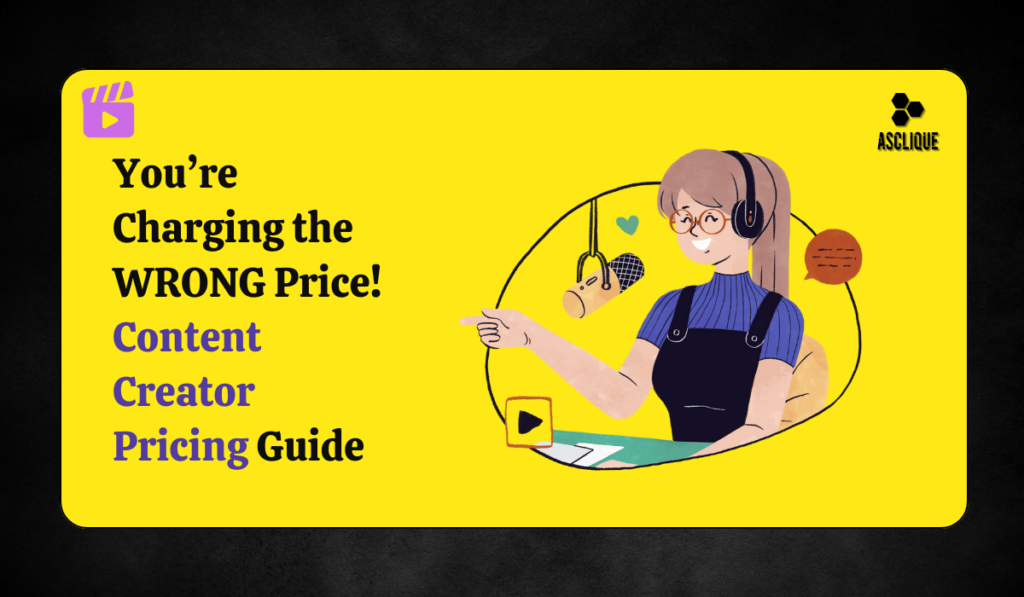Content development has now become a pretty attractive profession, as businesses and brands depend upon digital content to reach their target audience. A writer, graphic designer, social media manager, or video producer knows how much he or she wants to charge for his or her own time and expertise. This article discusses several pricing structures, industry standards, and variables that impact the rate. Irrespective of your level of experience, you’ll find valuable insights to help you determine what to charge as a content creator.
What is a Content Creator?
A content creator is a person who creates engaging and relevant content on different types of platforms. It may range from social media, blogs, YouTube, to podcasts. It can be self-created or for brands/influencers.
Types of Content Creators
- Writers – Produce blogs, articles, e-books, and social media captions.
- Videographers – Make YouTube videos, TikToks, and Reels.
- Graphic Designers – Create visuals, infographics, and branding materials.
- Podcasters – Give insight through audio content.
- Social Media Influencers- Create online communities and promote the brands.
Essential Competencies of Content Creators
- The ability to narrate compelling stories creatively
- Understanding of SEO and digital marketing
- Video and Image editing capabilities
- Ability to engage the audience
- Consistency and flexibility
Content creators generate income through brand deals, ad revenue, affiliate marketing, and selling digital products. The demand for entertaining content is still rising, and this is one of the lucrative career options.
Also Read: Content Marketing | Services, Types, Cost, Niche Specific, & Jobs
Knowledge of Pricing Models

Pricing models used by content creators differ with their niche, experience, and services. Knowing them can help decide what to charge or how to charge in ways that are competent and sustainable. Here are the most common ways of charging clients:
Hourly Rate
Generally, freelancing writers, graphic designers, video editors, and social media management charge by the hour. This is an open model where time spent on certain work, including revisions and research, is compensated fairly.
Common Hourly Rates:
- Beginner: $15 – $50 per hour
- Intermediate: $50 – $100 per hour
- Expert: $100 – $300+ per hour
Pros:
- Tends to follow an hourly wage in terms of output
- Works best for a larger project or consultant
Con:
- Unable to estimate cost in the end to the client
- Creative services does not tend to fit the per hour pricing structure
Per Word Rate (For Writers)
Typically freelance writers charge on a per-word basis, and more so on writing blog posts, articles, or copy. The model applies highly in journalism, SEO, or technical writing.
Popular Rates Per Word
- New writer: $0.03-$0.10/word
- Moderate: $0.10-$0.30 per word
- Expert: $0.30-$1+ per word
Example Calculation:
- A 1,000-word blog post at $0.10 per word would be $100
- A well-researched 2,000-word article at $0.50 per word could be $1,000
Advantages
- Cost is set on the outset in terms of the number of words
- Writer paid for amount of work that’s done
Disadvantages
- Research and project complexity cannot be charged on
- This kind of model will not apply on creative storytelling
Flat Rate Per Project
Most writers are comfortable with a project-based pricing structure. Clients are quoted an upfront price. This provides for more flexibility and greater potential earnings if efficiency is maximized.
Typical Project-Based Fees:
Blogging & Articles:
- 500-word article: $50 – $200
- 1,000-word article: $100 – $500
- 2,000+ words (SEO + research-intensive): $300 – $1,500+
Video Content:
- Short-form video (Reels, TikTok, Shorts): $100 – $1,500 per video
- YouTube video (5-10 min): $300 – $3,000+
- Full production (editing, scripting, voice-over): $500 – $10,000+
Pros:
- Clients know the total cost upfront
- Allows content creators to improve efficiency and maximize earnings
Cons:
- Can lead to scope creep if project terms are not well defined
- Might not be profitable if underestimated
Social Media Content Pricing
Social media creators can charge per post, per campaign, or on a monthly retainer basis. Prices depend on the platform, type of content, and engagement level.
Common Social Media Rates:
- Single post (image + caption): $50 – $300
- Carousel post (multiple slides): $100 – $500
- Short-form video post: $100 – $1,000
- Social media management (monthly retainer): $500 – $5,000+
Pros:
- Great for ongoing client relationships
- Can bundle services for higher earnings
Cons:
- Constant need for creating and participating in content
- Long term process, particularly in handling multi-channel activities
Influencer Marketing Pricing
Those content creators with strong social media profiles can turn their influence into income through the collection of a fee for sponsored content. These prices differ according to the audience size, engagement level, and niche.
Average Rates of Influencers:
- Micro-influencers: 1K-10K followers = $50-$500/Post
- Mid-tier influencers: 10K-100K followers = $500-$2,000/Post
- Macro-influencers: 100K – 1M+ followers= $2,000 – $10,000+ per post
Advantages:
- Much higher earning potential through brand partnerships
- Charge by level of engagement
Cons:
- Revenue may not be as predictable if strictly a sponsorship
- Has to consistently produce content and maintain audience engagement
What Affects Content Creator Fees
How much you can charge as a content creator depends on a number of factors, which include:
- Experience & Expertise
Typically beginners charge lower while experts can command a premium for their skills and reputation in their industry.
- Industry & Niche
Some industries pay more than others. For example, finance, healthcare, and technology content typically pay higher rates than lifestyle or entertainment content.
- Project Complexity
Content that requires extensive research, SEO optimization, or video editing will cost more than basic content.
- Client Budget & Business Size
Larger corporations often have bigger budgets than small businesses or startups, allowing content creators to charge higher rates.
- Turnaround Time
Most of these urgent projects are charged at rush fees between 10% to 50% above standard rates.
How to Set Your Rates as a Content Creator
When you don’t know what rate to charge, here is a step-by-step guide to ensure you are being paid at reasonable and profitable levels:
Calculate Your Costs
Factor in all expenses, including software subscriptions, internet, equipment (camera, microphone, editing tools), and administrative tasks like emails and invoicing. Your pricing should cover these costs while ensuring a profit.
Industry Standards Research
Look at what other professionals in your niche charge. Consider factors like experience level, content type, and industry demand. Online platforms, freelancer marketplaces, and networking groups can provide insights.
Test and Adjust
Start with low rates and adjust as you gain experience, build your portfolio, and as you get testimonials. Periodically assess the increase or decrease on the workload, demand, and growth of skills.
Packaging
The combination of services can greatly maximize earnings and give clients extra value. Examples:
- Starter Package: 4 social media posts + 1 blog post – $500
- Premium Package: 8 social media posts + 2 blog posts + 1 video- $2,000
Charge What You’re Worth
Avoid undervaluing your work. High-quality clients understand the value of expertise and are willing to pay for it. Confidence in your pricing attracts better opportunities and long-term success.
By strategically setting rates, you ensure fair compensation while growing a sustainable career as a content creator.
Common Pricing Mistakes to Avoid for Your Services
Charging Too Low
Many beginners underprice their work, thinking it will attract more clients. However, this can lead to burnout and financial instability. Value your skills and charge accordingly.
Not Having a Contract
A contract protects both you and your client by clearly defining payment terms, project scope, deadlines, and revision policies. Without one, you risk payment disputes and scope creep.
Ignoring Revisions
Unlimited revisions can suck the time and money out of you. In your pricing, define how many rounds of revisions are included—usually 1-2 rounds—to avoid too many edits.
Failure to Account for Taxes
You are responsible for your own taxes as a freelancer. Allocate a percentage of your income to taxes so that you are prepared when tax season rolls around.
Avoiding these mistakes will help you build a sustainable, profitable content creation business.
Additional Income Streams for Content Creators
Beyond client work, content creators can diversify their earnings with multiple revenue streams:
- Affiliate Marketing
Selling other’s products or services and earning money for each and every sale using your referral link. This can be a fabulous source of passive income.
- Selling Digital Products
Digital products such as e-books, online courses, templates, stock images, presets, etc generate income with low maintenance.
- Ad Revenue
You will earn money via YouTube’s Partner Program or showing ads on a website using an ad network, such as Google AdSense.
- Memberships & Subscriptions
Platforms like Patreon, Buy Me a Coffee, and YouTube Memberships let followers support you in exchange for exclusive content or perks.
- Brand Partnerships
Long-term collaborations with brands pay better than one-off sponsored posts, offering stable income and stronger industry relationships.
Content creators can build sustainable, scalable businesses by leveraging these income streams.
Conclusion
Building a long-lasting career as a content creator depends on knowing how much to charge. Your charges should reflect your abilities, expertise, and value to clients, whether you are charging on an hourly, project-by-project, or retainer basis. Knowing industry standards and adjusting accordingly will make you fairly compensated for your business.
FAQ’s
How do content creators make money?
Content creators earn through brand sponsorships, ad revenue, affiliate marketing, selling digital products, and offering services like writing, video editing, or social media management.
Do you need special skills to become a content creator?
Absolutely. Storytelling, SEO, video editing, and engagement are all valuable skills. For newbies, basic knowledge would do, which could be further learned over time.
Is content creation a full-time career?
Most content creators can earn a full-time income through diversified revenue streams and a solid online presence.
How do I start as a content creator?
Choose a niche, create high-quality content consistently, engage with your audience, and then look to monetize those content pieces through brand deals and digital products.
What are the best platforms for content creators?
Popular sites depend on the type of content you create, which can include YouTube, Instagram, TikTok, Twitter, and personal blogs.

